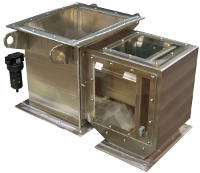Laura is celebrating her 5th birthday and, as the family gathers around the table to cut the cake, they are not thinking about the many facets of production that turned myriad raw materials into a safe, delicious birthday cake. But long before they became the cake mix that Laura’s mother purchased, raw materials such as flour, sugar, and spices had to undergo a controlled sequence of manufacturing operations. And among food manufacturers’ many quality controls, one of the most important is the strategic placement of magnets otherwise known as magnetic separation equipment.
Capturing Tramp Metals

When raw materials arrive at a food plant, they can contain many types of contaminants, including metals. Metals find their way into raw materials from harvest time through the many material handling processes needed to get them ready for packaging. These metal contaminants, known as tramp metals, must be removed by using different types of magnetic separators throughout the production facility.
Magnetic separators are installed on any product line where the removal of ferrous and weakly magnetic non-ferrous contaminants is necessary to ensure product purity, prevent damage to machinery, and eliminate hazards associated with tramp metals. As the name implies, magnetic separators use high-strength magnets to attract, separate, capture, and retain ferrous metals.
Recently, a global food processor faced a challenge. As cake-mix ingredients are processed, they pass through a chute and flow between several plate magnets (a type of magnetic separator) which are designed to trap and contain any tramp metals that have made their way into the mix. From there, the safe ingredients move to the next operation.
Plate magnets are commonly used in food plants because they are easy to integrate into existing chutes. Most plant equipment requires regular maintenance, and for magnetic separators it is no different; that means regular cleaning. An unclean magnet can allow a buildup of tramp metal that diminishes the magnet’s effectiveness. Also, a magnet with significant buildup can plug a chute and hinder product flow.
Several of the food processor’s plate magnets had been installed in a tight and hard-to-reach area. Cleaning was difficult because of the magnets’ location, size, and weight. Production had to be stopped when the company’s maintenance personnel performed the scheduled daily cleaning. Tricky to reach and heavy to lift, the magnets presented a distasteful, labor-intensive cleaning task for plant workers. But anything less than regular, thorough, proper cleaning would create risks unacceptable to a highly trusted and respected food manufacturer.
Seeking a solution to this long-standing cleaning challenge, the food processor contacted Magnetic Products, Inc. (MPI).
Mini Magnet Provides Big Solution
After visiting the plant, MPI proposed a solution that would solve the cleaning issue while improving tramp-metal capture rates. The two manually cleaned plate magnets would be replaced by one MPI automatic self-cleaning mini free-flow cylinder magnet.
MPI’s exclusive self-cleaning mini free-flow magnet, available in both manually operated quick-clean and automatic self-clean designs, captures both large and small tramp metal from high-volume, vertical-gravity-fed product streams. The cake-mix ingredients would now flow directly into the magnet without restriction, resulting in higher tramp metal removal. The free-flow magnet’s 6-sided rare-earth magnets provide a higher “reach out” magnetic field that attracts and retains large and small ferrous material.
The mini free-flow magnet is engineered to fit into tight spaces such as that at the manufacturing facility. No longer would maintenance personnel need to squeeze into uncomfortable positions to disassemble and clean magnets. The task would now fall to the machine operator, who would simply flip a valve to clean the magnet. Cleaning time was dramatically cut, resulting in an 85% reduction in labor costs. An added benefit was increased tramp-metal retention.
Thanks to dedicated food manufacturing companies and their partner vendors, little Laura’s only worry about her delicious birthday cake will be whether she gets the biggest slice.





